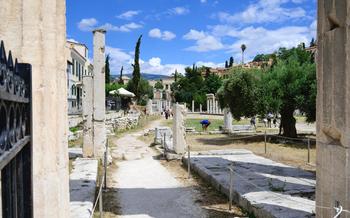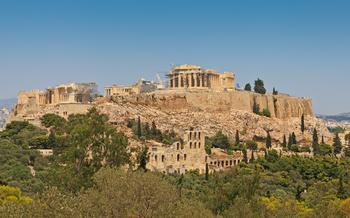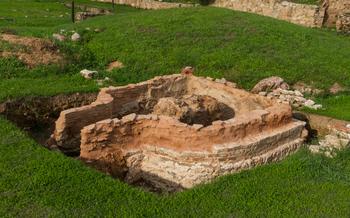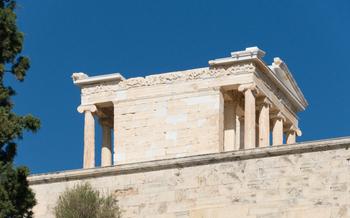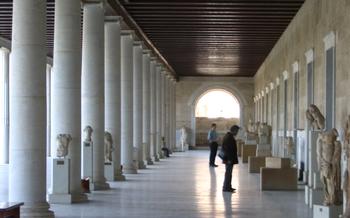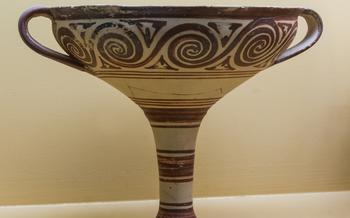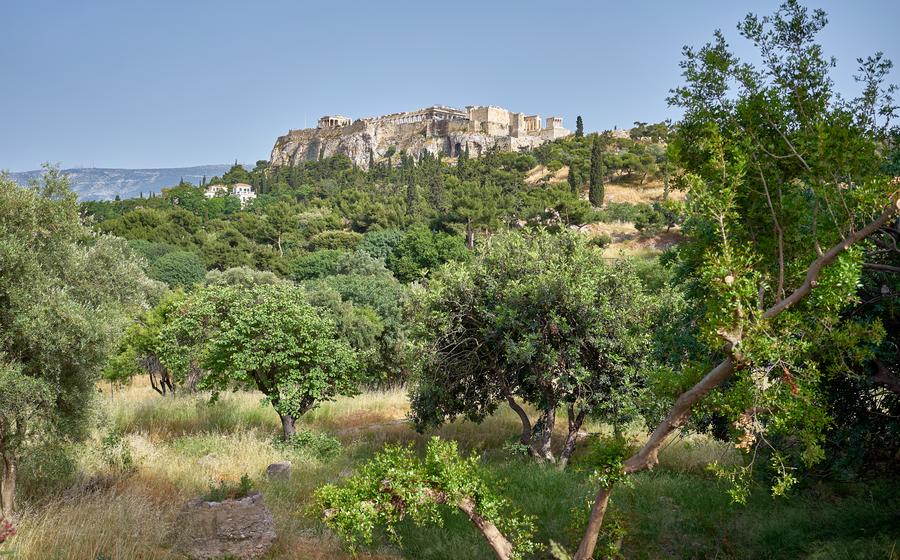
Agora Archaeological Site
- Unveiling the Ancient Agora: A Journey Through Time
- Strolling the Sacred Way: A Path of Reverence
- Admire the Temple of Hephaestus: A Symbol of Craftsmanship
- Unearthing the Stoa of Attalos: A Marketplace Masterpiece
- Marveling at the Altar of the Twelve Gods: A Place of Worship
- Discovering the Odeon of Agrippa: A Theater for Music and Recitals
- Exploring the Museum of the Ancient Agora: A Treasure Trove of Artifacts
- Admiring the Erechtheion: An Architectural Masterpiece
- Walking the Panathenaic Way: A Path of Celebration
- Significance and history of the Panathenaic Way
- Religious processions and festivals
- Architectural landmarks along the route
- Imagining the grandeur of ancient Athenian festivals
- Visiting the National Archaeological Museum: A Treasury of Antiquities
- Exploring the Ancient Cemetery: A Glimpse into Athenian Burial Practices
- Taking a Guided Tour: Unveiling Hidden Stories
- Insider Tip: Enhance Your Experience
Unveiling the Ancient Agora: A Journey Through Time
In the heart of Athens, nestled amidst the bustling modern city, lies the Ancient Agora, a place that whispers tales of a glorious past. Once the vibrant center of Athenian life, the Agora served as a marketplace, a political hub, a religious sanctuary, and a judicial court.
As you step into this archaeological site, you'll be transported back in time, surrounded by ancient ruins that evoke the spirit of a bygone era. The Agora's rich history and significance make it a must-visit destination for anyone seeking to unravel the mysteries of ancient Greece.
Conveniently located near the Acropolis, the Agora is easily accessible by foot or public transportation. Prepare to be captivated by its architectural highlights, including the well-preserved Temple of Hephaestus, the impressive Stoa of Attalos, and the awe-inspiring Altar of the Twelve Gods. Don't miss the opportunity to explore the Museum of the Ancient Agora, which houses a treasure trove of artifacts that bring the site's history to life.
Strolling the Sacred Way: A Path of Reverence
The Sacred Way, a majestic boulevard in ancient Athens, served as a processional route for religious ceremonies and festivals. This thoroughfare, lined with significant landmarks and monuments, connected the Agora with the Acropolis, the religious heart of the city.
The Sacred Way was more than just a path; it was a journey of spiritual significance, where Athenians and visitors alike paid homage to their gods and goddesses. Along its course, they encountered various sanctuaries, altars, and statues, each holding a unique place in Athenian religious practices.
One of the most prominent landmarks on the Sacred Way was the Stoa Poikile, a colonnaded walkway adorned with vibrant paintings depicting scenes from Greek mythology. Within this stoa, philosophers gathered to debate and exchange ideas, contributing to Athens' reputation as a center of intellectual discourse.
As you walk along the Sacred Way, you can't help but feel a sense of awe and reverence. Imagine the processions that took place here, with citizens dressed in their finest attire, carrying offerings to the gods, and participating in religious rituals that connected them to the divine.
Admire the Temple of Hephaestus: A Symbol of Craftsmanship
Standing proudly amidst the ruins of the Ancient Agora, the Temple of Hephaestus is a testament to the exceptional craftsmanship and architectural prowess of ancient Greece. Dedicated to Hephaestus, the patron god of metalworking, craftsmanship, and fire, this temple is one of the best-preserved examples of Doric architecture in the world.
Its well-proportioned columns, intricate pediments, and finely carved friezes showcase the mastery of ancient Greek builders. The temple's interior once housed a colossal bronze statue of Hephaestus, a testament to the god's importance in Athenian society.
Comparing this temple to other significant temples in Greece, one can appreciate the unique features that set it apart. While the Parthenon on the Acropolis may be more famous, the Temple of Hephaestus is arguably better preserved, offering a more complete glimpse into the grandeur of ancient Greek architecture.
Its proximity to the Stoa of Attalos and other important Agora landmarks makes it a must-see for anyone exploring this ancient marketplace. Whether you're a history buff, an architecture enthusiast, or simply someone who appreciates beauty, the Temple of Hephaestus is sure to leave a lasting impression.
Unearthing the Stoa of Attalos: A Marketplace Masterpiece
Amidst the ruins of the Ancient Agora, the Stoa of Attalos stands as a testament to the vibrant commercial and social life of ancient Athens. Constructed in the 2nd century BC by King Attalos II of Pergamon, this magnificent stoa, or covered walkway, served as a marketplace, a meeting place, and a symbol of the city's prosperity.
With its Doric columns, marble floors, and intricate carvings, the Stoa of Attalos is an architectural masterpiece. It once housed over 40 shops, each specializing in different goods, from textiles to pottery to jewelry. Merchants displayed their wares, haggled with customers, and engaged in lively conversations, creating a bustling atmosphere that echoed through the Agora.
Beyond its commercial function, the Stoa of Attalos also played a vital role in Athenian society. It served as a gathering place for citizens to discuss politics, philosophy, and the latest news. Philosophers like Socrates and Plato may have strolled through its colonnades, engaging in spirited debates that shaped the intellectual landscape of ancient Greece.
Today, the Stoa of Attalos has been meticulously reconstructed, offering visitors a glimpse into the vibrant commercial and social life of ancient Athens. As you wander through its restored shops, you can almost hear the hum of voices, the clinking of coins, and the laughter of people going about their daily lives. The Stoa of Attalos stands as a reminder of the enduring legacy of ancient Greek culture, where commerce, politics, and philosophy intertwined to create a thriving and influential civilization.
Marveling at the Altar of the Twelve Gods: A Place of Worship
Amidst the ruins of the Ancient Agora, the Altar of the Twelve Gods stands as a testament to the religious beliefs and practices of ancient Athens. Erected in the 6th century BC as a place of worship for the city's patron deities, this altar held immense significance in the religious life of the Athenian people.
Constructed from massive blocks of limestone, the altar features a simple yet imposing design, exuding an aura of solemnity and reverence. Its rectangular shape and elevated platform created a sacred space where offerings were made to honor the twelve Olympian gods.
Ancient Athenians would gather around the altar to participate in religious rituals and ceremonies, seeking guidance and protection from the divine. Offerings of food, drink, and precious objects were presented to the gods, accompanied by prayers and libations.
The altar served as a focal point for communal worship, fostering a sense of unity and piety among the citizens of Athens. It was a place where they could come together to honor their deities, express their gratitude, and seek divine favor.
Today, visitors can marvel at the well-preserved remains of the Altar of the Twelve Gods, immersing themselves in the spiritual atmosphere of ancient Athens. The altar stands as a poignant reminder of the deep religious beliefs that shaped the lives and culture of this ancient city-state.
Discovering the Odeon of Agrippa: A Theater for Music and Recitals
Amidst the ruins of the Ancient Agora, discover the Odeon of Agrippa, an exquisite theater that once resonated with the melodies of ancient performances. Built in the 1st century BC by Marcus Vipsanius Agrippa, a close friend of Emperor Augustus, this magnificent structure served as a venue for musical concerts, recitals, and other cultural events.
With a seating capacity of approximately 1,200 spectators, the Odeon of Agrippa was a marvel of ancient acoustics. Its carefully designed shape and arrangement of seats ensured that the sound carried clearly throughout the theater, creating an immersive experience for the audience. Imagine the atmosphere as musicians plucked their lyres, singers filled the air with their voices, and poets recited their verses, captivating the hearts and minds of the Athenian elite.
The Odeon's architectural features are a testament to the ingenuity of ancient builders. Its semi-circular auditorium is surrounded by a colonnade of elegant Corinthian columns, creating a harmonious blend of form and function. The stage area, adorned with intricate carvings, provided a platform for performers to showcase their talents.
Transport yourself back in time as you step into the Odeon of Agrippa, envisioning the vibrant cultural scene of ancient Athens. Picture the theater alive with the sounds of music, the applause of the audience, and the passionate voices of performers. Here, art and culture flourished, enriching the lives of Athenians and leaving an indelible mark on the history of theater.
Exploring the Museum of the Ancient Agora: A Treasure Trove of Artifacts
The Museum of the Ancient Agora, located within the archaeological site, is a treasure trove of artifacts that provide a glimpse into the daily lives, art, and religion of ancient Athens. As you wander through its galleries, you'll discover a captivating collection of pottery, sculptures, tools, and religious objects that bring the past to life.
Among the highlights of the museum's collection are fragments of the famous "Stoa Poikile," a painted porch that once adorned the Agora. These beautifully preserved frescoes depict scenes from Greek mythology and history, offering a glimpse into the artistic prowess of ancient Athenian painters.
Another highlight is the "Law Code of Gortyn," an inscribed stone tablet dating back to the 5th century BC. This remarkable artifact provides insights into the legal system of ancient Crete, shedding light on the development of law and justice in the ancient Greek world.
Interactive exhibits and displays enhance the museum experience, allowing visitors to engage with the artifacts and learn more about the ancient Athenian culture. Through hands-on activities and multimedia presentations, you can explore the Agora's history, architecture, and significance in a captivating and interactive way.
Visiting the Museum of the Ancient Agora is an essential part of any trip to Athens. It's a place where you can delve deeper into the fascinating world of ancient Greece, uncovering the stories and secrets of a civilization that continues to inspire and captivate us today.
Admiring the Erechtheion: An Architectural Masterpiece
Amidst the ruins of the Ancient Agora, the Erechtheion stands as a testament to the architectural prowess and religious devotion of ancient Athens. Erected between 421 and 406 BC, this temple holds a unique place in Greek history and mythology. Dedicated to both Athena Polias, the patron goddess of Athens, and Poseidon, the god of the sea, the Erechtheion served as a center of religious ceremonies and political gatherings.
Marvel at the intricate details adorning the temple's exterior. Its Ionic columns, with their graceful volutes, frame the entrance, while the north porch features the iconic Caryatid maidens. These six sculpted female figures, each standing over six feet tall, support the entablature with their heads and arms, embodying both strength and elegance. Their serene expressions and flowing drapery have captivated visitors for centuries.
Step inside the Erechtheion to discover a labyrinth of chambers and sanctuaries. The east chamber was dedicated to Athena Polias, housing her ancient wooden cult statue. The west chamber, known as the Erechtheum, was believed to be the burial place of the mythical king Erechtheus. Here, you can admire the sacred olive tree, said to have been planted by Athena herself, and the mark of Poseidon's trident, left as a symbol of his claim to the city.
The Erechtheion's architectural innovations and religious significance make it a must-see for any visitor to the Ancient Agora. Its enduring beauty and historical importance continue to inspire awe and wonder, inviting us to delve deeper into the rich tapestry of ancient Athenian culture.
Walking the Panathenaic Way: A Path of Celebration
Significance and history of the Panathenaic Way
The Panathenaic Way was a grand processional route in ancient Athens, stretching from the Dipylon Gate to the Acropolis. Along its path, religious processions and festivals took place, most notably the annual Panathenaic Festival, which celebrated the birthday of the goddess Athena and the unity of the Athenian people.
Religious processions and festivals
The Panathenaic Festival was one of the most important religious festivals in Athens, held every four years. The highlight of the festival was a grand procession that made its way along the Panathenaic Way. The procession included priests, magistrates, citizens, and foreigners, all dressed in their finest attire. They carried offerings to Athena, including a new peplos, or robe, for her statue in the Erechtheion.
Architectural landmarks along the route
The Panathenaic Way was lined with numerous architectural landmarks, including temples, statues, and altars. Some of the most notable landmarks include the Stoa Poikile, a painted portico where philosophers and poets gathered, and the Odeon of Herodes Atticus, a theater built by the Roman consul Herodes Atticus.
Imagining the grandeur of ancient Athenian festivals
Walking along the Panathenaic Way today, one can easily imagine the grandeur and excitement of the ancient Athenian festivals. The streets would have been filled with music, dancing, and laughter as the procession made its way towards the Acropolis. The air would have been filled with the scent of incense and the sound of prayers and hymns. It is a truly immersive experience that transports visitors back in time.
Visiting the National Archaeological Museum: A Treasury of Antiquities
Enrich your understanding of ancient Greek civilization with a visit to the National Archaeological Museum, a treasure trove of antiquities that houses some of the most remarkable artifacts from across Greece. Wander through its impressive galleries and discover a vast collection of sculptures, pottery, jewelry, and more, each piece telling a story of the rich cultural heritage of this ancient land.
Marvel at the exquisite craftsmanship of the gold Mask of Agamemnon, a stunning relic from the Mycenaean civilization. Admire the intricate details of the Parthenon sculptures, which once adorned the iconic temple on the Acropolis. Gaze upon the serene beauty of the Charioteer of Delphi, a bronze statue that captures the essence of athleticism and grace.
The museum's collection extends beyond the classical period, showcasing artifacts from various eras and regions of Greece. Explore the Minoan civilization through the vibrant frescoes and pottery from the Palace of Knossos. Encounter the Hellenistic art of Pergamon, with its dramatic sculptures and architectural fragments.
Allow yourself to be captivated by the stories behind these ancient treasures, as you trace the development of Greek art and culture through the ages. The National Archaeological Museum is a must-visit for anyone seeking a deeper understanding of the rich history and legacy of ancient Greece.
Exploring the Ancient Cemetery: A Glimpse into Athenian Burial Practices
To the west of the Agora lies the ancient cemetery, a poignant reminder of the lives and deaths of ancient Athenians. Stroll among the rows of stone grave markers, each telling a unique story. Some graves are simple, bearing only a name and a few words of remembrance. Others are more elaborate, adorned with intricate carvings and sculptures depicting scenes from the deceased's life.
The cemetery offers a glimpse into Athenian burial practices, which evolved over time. In the early days, Athenians buried their dead in simple pits or trenches. Later, they adopted the practice of cremation, placing the ashes of the deceased in urns or jars. The cemetery also contains a number of family tombs, where multiple generations of a family were laid to rest.
As you explore the cemetery, take a moment to reflect on the lives and deaths of the people who were buried here. Imagine the mourners who gathered to bid farewell to their loved ones, and the rituals and ceremonies that accompanied the burial. The ancient cemetery is a place of remembrance and reflection, a reminder that even in death, the people of ancient Athens were connected to their community and to the city they called home.
Taking a Guided Tour: Unveiling Hidden Stories
Enhance your experience at the Ancient Agora by embarking on a guided tour. Led by knowledgeable experts, these tours provide an immersive journey through time, revealing hidden stories and insights that bring the site to life. Guides share anecdotes, historical context, and archaeological discoveries, allowing visitors to connect with the past on a deeper level. Specialized tours are available for those with specific interests, such as architecture, religion, or daily life in ancient Athens. By booking a guided tour, you'll gain a comprehensive understanding of the Agora, making your visit even more enriching and memorable.
Insider Tip: Enhance Your Experience
-
Early Bird: To beat the crowds and capture the Agora's tranquility, aim to arrive early in the morning. The soft light casts a magical glow on the ruins, creating picturesque moments for photography.
-
Avoid the Midday Sun: The heat and intensity of the midday sun can be overwhelming. Plan your visit for the cooler hours, either early morning or late afternoon, to fully appreciate the Agora's charm without discomfort.
-
Capture the Essence: The Agora's ancient ruins offer a treasure trove of photographic opportunities. Experiment with different angles, play with shadows, and focus on details to capture the essence of this historical site.
-
Savor Authentic Flavors: After exploring the Agora, indulge in a delicious Greek meal at a local taverna. Ask your guide for recommendations or venture off the beaten path to discover hidden culinary gems. The flavors and hospitality will leave a lasting impression of your Athenian experience.
